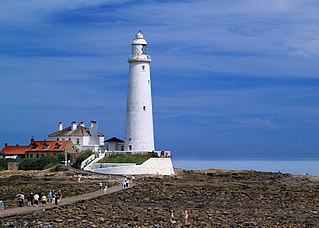
Tyne and Wear is a ceremonial county in North East England. It borders Northumberland to the north and County Durham to the south, and the largest settlement is the city of Newcastle upon Tyne.

North Tyneside is a metropolitan borough in the metropolitan county of Tyne and Wear, England. It forms part of the greater Tyneside conurbation. North Tyneside Council is headquartered at Cobalt Park, Wallsend.
Killingworth is a town in North Tyneside, Tyne and Wear, England, within the historic county of Northumberland.

The Department for Work and Pensions (DWP) is a ministerial department of the Government of the United Kingdom. It is responsible for welfare, pensions and child maintenance policy. As the UK's biggest public service department it administers the State Pension and a range of working age, disability and ill health benefits to around 20 million claimants and customers. It is the second-largest governmental department in terms of employees, and the second largest in terms of expenditure.

Newcastle railway station is a heritage-listed closed railway station on the Newcastle railway line at Newcastle, New South Wales, Australia. It was the main railway station and terminus station prior to the curtailment of the Newcastle railway line.
Longbenton High School is a smaller than average Secondary School located in Benton, North Tyneside, England. Operating under the two-tier system in North Tyneside, the school takes students from age 11-18. The school building also includes a very small Sixth Form, joint with George Stephenson High School. The joint sixth form used to be in partnership with Seaton Burn College and branded as the Northwest Cluster. However now it is simply known as 'NE12 Sixth Form', as both campuses fall under the NE12 Postcode. This change was not advertised at all by the school, both internally or externally.

Longbenton is a Tyne and Wear Metro station, and former British Rail station, in the English metropolitan county of Tyne and Wear. It was originally opened on 14 July 1947 by the North Eastern Railway, and became part of the Tyne and Wear Metro on 11 August 1980. It should not be confused with a previous station, on the site of the current Four Lane Ends Metro station, that opened in 1864, closed in 1871, and was variously called Benton, Long Benton and Longbenton.

The Four Lane Ends Interchange is a multimodal transport hub in the borough of North Tyneside in the English metropolitan county of Tyne and Wear. It includes a station on the Tyne and Wear Metro, a bus station and a multi-storey car park. The metro station opened on 11 August 1980, but it is situated on the site of a previous station that opened in 1864, closed in 1871, and was variously called Benton, Long Benton and Longbenton.

Longbenton is a district of North Tyneside, in the county of Tyne and Wear, England. It is largely occupied by an extensive estate originally built as municipal housing by Newcastle City Council in the 1930s and extended in the 1950s. It is served by the Tyne and Wear Metro stations Longbenton Metro station and Four Lane Ends Metro Station. Nearby places are Killingworth, Forest Hall, Four Lane Ends, West Moor, Heaton and South Gosforth, in Newcastle upon Tyne. The Longbenton and Killingworth Urban Area had a population of 34,878 in 2001. This figure increased to 37,070 in 2011.

Gosforth is an area of Newcastle upon Tyne, England, situated north of the City Centre. It constituted a separate urban district of Northumberland from 1895 until 1974 before officially merging with the city of Newcastle upon Tyne. In 2001, it had a population of 23,620.

Procter & Gamble (P&G) has a long history on Tyneside, starting from its purchase of Thomas Hedley Co. in 1930. Thomas Hedley was a company local to Newcastle upon Tyne, and was the start of P&Gs expansion from its American operations. P&G moved into Hedley's Newcastle City Road site, and had its headquarters in Collingwood Street, Newcastle. It continued its UK operations by opening up a Manchester factory in 1933, and constructing a London plant in 1937, however, it was Tyneside where P&G was solidly based. By 1948 these offices were proving inadequate for an expanding post-war business, and in 1953 P&G moved its UK administrative centre to purpose built offices in Gosforth, Newcastle. The building was named Hedley House, in remembrance of the roots of P&G in Tyneside.

Howdon is a largely residential area in the eastern part of Wallsend, Tyne and Wear, England. It consists of High Howdon and the smaller settlement of East Howdon. Much of the High Howdon area was formerly called Willington prior to post-World War II urbanisation. The North Tyneside ward population at the 2011 Census was 11,129.

Jesmond Park Academy is a coeducational secondary school and sixth form located in Heaton, Newcastle upon Tyne, England.

Benton is an area of North Tyneside in Tyne and Wear, England. It is 4 miles (6 km) to the north east of Newcastle upon Tyne. The parish of St Bartholomew, Longbenton, is within the North Tyneside district. The population of the North Tyneside Ward taken at the Census 2011 was 10,359. The area is contiguous with the suburbs of Newcastle.
Forest Hall is a village in the borough of North Tyneside, Tyne and Wear, England. It is 4 miles from Newcastle upon Tyne. It borders Killingworth to the north, Holystone to the east and Benton to the south. The village was named after the Forest Hall, which incorporated a medieval tower. Woodside Court was built on the site of the Hall, which was demolished in 1962.

Tyneview Park is a large government office site in Benton, Newcastle upon Tyne, England. Tyneview Park is home to many departments of The Pension Service, a sector of the Department for Work and Pensions and HMRC.

South Gosforth Traction Maintenance Depot is a vehicle cleaning, maintenance and stabling facility used by the Tyne and Wear Metro, located in Gosforth, Newcastle upon Tyne in Tyne and Wear, England.

Teville Gate is a construction site and car park in Worthing in West Sussex, England. Covering about 1.4 hectares the site lies at the main entrance to the town centre of Worthing for both rail, via Worthing railway station, and road, via the A24 and A27. The site is bounded by Railway Approach to the north, the A24 Broadwater Road to the east, the A2031 Teville Road to the south and Grand Victorian Hotel to the west.

Cobalt Park is a business park located in North Tyneside, England. It is one of the largest business parks in the United Kingdom.

Carliol House is a Grade II listed building in Newcastle upon Tyne that curved the corner of Market Street East and Pilgrim Street in the city-centre. As of 2024 only the façade of the building remains.


















